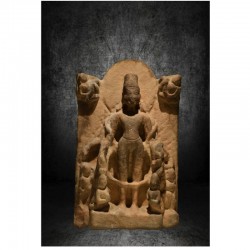



Fresco carved in pink sandstone. Vaikuntha, Gupta period, 4th-5th century, presumably from Mathura, North India.
Height: 24 cm
Width: 14 cm
Depth: 5 cm
Weight: 3396 g
Unmounted - Museum quality
The Gupta dynasty settled in the North of India at the end of the 3rd century but its origins are not well known. From the 4th century, they developed, reached their peak during the first half of the 5th century and then declined following external invasions. We remember from this short period of history the names of Chandragupta and Samudragupta during the reign of Kumâragupta and his son Skandagupta. During this short period of history, Brahmanism (which we now call Hinduism) and Buddhism coexist. In terms of sculpture, we generally speak of the schools of Mathura and Sārnāth and the temple of Deogarh.
The piece presented for sale was initially described as a representation of Visnu accompanied by two servants.
Now, we know that during the first three centuries of our era, Krsna was presented as an "aratara" of Visnu or the form that Visnu took when he descended on earth.
This particular relationship between Visnu and Krsna is at the base of the appearance in the region of Mathura, in representations of god with three heads called "VAIKUNTHA" and in particular, at the Gupta period of time.
It is in the Mathura school that we see Visnu, a god with 4 arms, standing out on a large halo. Experts generally agree that 7 to 8 sculptures of this type, from Mathura, have been identified and that they represent the oldest examples of this type of Visnu.
One of them is on display at the Archaeological Museum of Mathura (D28). It is repeated and described in the remarkable book by Charlotte Schmid "Asian Arts", page 63.
Note that the piece exhibited at the Mathura museum is very similar to the one we are selling. We have the photo of this part and it will be sent on request.
Acquired during the first half of the 20th century, it enters a private collection. It is neither mounted nor exposed. The owner at the time sold this piece to a Belgian investor. The piece is presented for sale in Italy and goes through the hands of experts in 2017. In 2020, the current French owner decides to sell this piece and mandates our company to do so.
This piece is currently visible in the suburbs of Paris or in Brussels by appointment.
This piece, of museum quality, is sold raw, unmounted but may be exhibited without support.